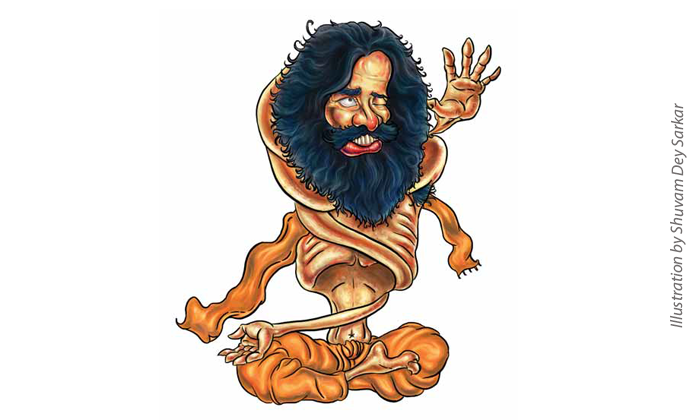The month of June saw Baba Ramdev making a comeback to newspaper headlines, rejoining anti-corruption crusader Anna Hazare, and calling to mind Marx’s old chestnut about history repeating itself: first as tragedy, then as farce. (Not that the first time wasn’t farcical, with Ramdev trying to escape the police by donning women’s clothing.)
Just two days after Anna and Ramdev shared the stage, news broke of another yogi on the other side of the world, who was engulfed in controversy of a very different kind. Michael Roach, a Buddhist teacher and practitioner of yoga and tantra, had been implicated in the death of one of his students in the American southwest. The story was briefly the most e-mailed article on The New York Times website. It was covered more colourfully by New York magazine the following day, under the headline “There Was a Bizarro Yoga-Cult Death in the Desert.”
Bizarre, indeed. Roach had first graced the pages of The New York Times in 2008, again in a most e-mailed article, which described the odd relationship between Roach and Christie McNally, a yogi twenty years his junior. They had vowed to stay within fifteen feet of each other, forever. Though the pair claimed to be celibate, mainstream Buddhist monks urged Roach to renounce his monastic vows, with even the Dalai Lama distancing himself from Roach. The 2012 article revealed that Roach and McNally had secretly been married. They divorced in 2010, and McNally then married one of Roach’s senior students, Ian Thorson. In February 2012, McNally and Thorson were expelled from Roach’s three-year, three-month, three-day silent retreat in the Arizona desert, after which they decided to camp on their own. Their isolation led to Thorson’s death; McNally was found next to him, dehydrated and delirious.
“Just two days after Anna and Ramdev shared the stage, news broke of another yogi on the other side of the world, who was engulfed in controversy of a very different kind. Michael Roach, a Buddhist teacher and practitioner of yoga and tantra, had been implicated in the death of one of his students in the American southwest. “
This gruesome story and Ramdev’s political antics have little immediate connection. But the popularity of both stories in the news points to the symbiotic relationship between yogis and the mass media. Although Michael Roach surely did not want to be in the newspapers in June (while Baba Ramdev clearly did), both have built up their images and reputations largely through the media: TV appearances, books, interviews and the like. Both Roach and Ramdev are uncanny salesmen, able to perceive the spiritual and material needs of their respective societies, and to find marketable ways to tap into those needs. And both draw on spiritual traditions that are far more flexible and amorphous than they appear at first glance.
Ramdev rocketed to fame as the star of the Aastha TV lineup. Eventually, Ramdev’s own company, Vedic Broadcasting Limited, bought Aastha. The top three programmes on religious TV channels, all star Ramdev. His mass appeal has often been linked to the rise of the neoliberal regime in India. He offers, say journalists Varghese K George and Charu Sudan Kasturi, a MacYoga that brings “on demand, instant gratification.” He caters to the rising middle classes, offering a way to retain “traditional” beliefs and values while fighting the proliferating diseases of affluence like Type 2 diabetes. While his harshly conservative views (especially his gay-bashing) have raised some eyebrows, his followers remain enthralled as the ever-optimistic Ramdev claims that his ancient wisdom can cure even cancer and AIDS.
Roach’s career has been more modest, though he has hardly been less boastful in his claims, citing Tibetan Buddhism (or his brand of it) as the only real cure for Western society’s ailments. Roach studied for six years at a Tibetan Buddhist monastery in New Jersey, and earned the title of geshe (something like a Buddhist Ph.D.) at a monastery near Mysore. He also founded a highly profitable jewelry company that was eventually sold to Warren Buffett. Partially based on his experience, he wrote the book ‘The Diamond Cutter: The Buddha on Managing Your Business and Your Life’. Like Ramdev, he is a spiritual leader for a capitalist age.
Ramdev and Roach have both become media favourites, though at varying scales: Ramdev’s fame being pan-Indian and even international, while Roach’s is confined to the small American Buddhist community. Both have also drawn the ire of more traditional practitioners. One sanyasi warned that Ramdev’s style of yoga “can have severe negative impacts,” while many Buddhist leaders consider Roach to be at best eccentric and at worst megalomaniacal.
Such accusations seem to be the norm for the up-and-coming yogi-showman. It was certainly the case with Pierre Arnold Bernard – a clear predecessor of Ramdev and Roach, a man known as “The Great Oom,” and the first populariser of hatha yoga in America. Bernard was accused of being little more than a clever huckster, and, like Roach, he clearly had a head for business and spectacle. He managed a semi-pro baseball team, staged three-ring circuses and kept a zoo on his premises. He was also a charismatic teacher, and – more than that – a serious scholar and practitioner of hatha yoga.
The larger-than-life figure of Bernard also helps untangle the web of hidden connections between Ramdev and Roach. Bernard was initially interested in the more secretive, tantric side of yoga; in 1905, he founded the Tantrik Order of America. This scandalized a Victorian America, leading to a series of police raids. But Bernard persevered. He eventually found more success by emphasizing the health benefits of yoga. The seeds he planted bore fruit with the yoga boom of the 1960s in America. While Roach has taken a page from Bernard’s earlier career (with a Buddhist twist), Ramdev has inherited his later role of health guru.
And while Ramdev may denounce all things Western, the resurgence of hatha yoga in India is largely tied to its popularity in the States through the workings of the so-called “pizza effect.” Americans have taken yoga and made it their own; Indians, seeing the great success of their “heritage” abroad, have reclaimed it, adding a new stamp of authenticity to what is, in reality, a thoroughly hybridised practice. So as Ramdev uses his media soapbox to extol Vedic tradition, it’s useful to remember all he shares with – and all he owes to – American yogis.














